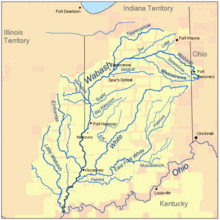Battle of Wild Cat Creek facts for kids
Quick facts for kids Battle of Wild Cat Creek |
|||||||
|---|---|---|---|---|---|---|---|
| Part of the War of 1812 | |||||||
 |
|||||||
|
|||||||
| Belligerents | |||||||
| Indigenous Confederacy: Kickapoo Winnebago Shawnee Supported by: |
7th Infantry Kentucky Infantry Indiana Rangers |
||||||
| Commanders and leaders | |||||||
|
Samuel Hopkins Kumakskau Shawnee brother of Tecumseh in command |
|||||||
| Strength | |||||||
| 1,200 | 1,250 | ||||||
| Casualties and losses | |||||||
| none | 17 killed 3 wounded |
||||||
The Battle of Wild Cat Creek happened in November 1812. It was part of a military mission by American forces against Native American villages during the War of 1812. This battle is sometimes called "Spur's Defeat". This name likely comes from the spurs soldiers used to make their horses gallop away quickly from the fight. Some people also call this event the Second Battle of Tippecanoe.
Contents
The Second Tippecanoe Campaign
After some difficult battles and attacks in 1812, like the events at Fort Dearborn and Pigeon Roost, the American military decided to send a joint mission. Major General Samuel Hopkins and Colonel William Russell led this mission into the Illinois area.
Colonel Russell, who had just been at the attack on Fort Harrison, led a group of Illinois militia and Indiana Rangers. He successfully destroyed a Kickapoo village near Peoria Lake. However, Russell had to go back to Cahokia because he couldn't find Hopkins's forces. Hopkins had trouble getting his Kentucky militia to fight. They were forced back to Vincennes when the Kickapoo started a large prairie grass fire.
Hopkins was very disappointed by this setback. He sent the Kentucky militia under his command home. Then, he gathered a new army. This new army included three groups of Kentucky Infantry, one company of the 7th Infantry led by Major Zachary Taylor, a group of Indiana Rangers, and a company of scouts. Hopkins left Vincennes on November 11, 1812. He marched north, following the same path William Henry Harrison had taken in 1811.
Reaching Prophetstown
The army arrived at Prophetstown on November 19. Prophetstown was a Native American village that had been destroyed in the 1811 Battle of Tippecanoe. It was partly rebuilt, with an even larger Kickapoo village nearby. However, all the people and supplies had been moved out before the army arrived. Hopkins's army then burned both villages to the ground.
A Winnebago village was found nearby, along Wildcat Creek. Hopkins decided to attack it. Colonel Miller led 300 men and destroyed this village, which was also empty. On November 21, a small group of scouts was exploring the creek when they were fired upon. The entire scouting group quickly went back to rejoin the main army.
The Ambush at Wild Cat Creek
The next day, November 22, Colonels Miller and Wilcox went with Captain Beckes and sixty Indiana Rangers. After riding about six miles up Wildcat Creek, they saw a Native American person teasing them. Thirteen Indiana Rangers were very angry about this. They chased the rider, but he stayed ahead of them. He led them into a tight valley.
Here, Kickapoo, Winnebago, and Shawnee warriors attacked the Rangers by surprise. In just two minutes, twelve men and several horses were killed or badly hurt. Many of the American officers were killed, and the Rangers ran away. One man escaped by using his spurs to make his horse gallop faster. This is why the battle was nicknamed "Spur's Defeat."
The American forces lost seventeen men killed and three wounded on November 21–22.
Retreat and Aftermath
Scouts soon learned that a large group of Native Americans was gathering to fight Hopkins's army. The Americans prepared for battle right away. However, the weather turned very cold, and a snowstorm began. When the Native American camp was reached on November 24, it was empty.
Hopkins decided to turn back. He stopped at Fort Harrison to recover from the bad weather before continuing to Vincennes. By the time they reached Fort Knox, two hundred men were sick or suffering from frostbite. Hopkins became very sad because of his losses and resigned from his command. He later faced a military review for his actions in the Illinois area and Prophetstown. He was found not guilty of any wrongdoing and later ran for the Senate.
Why This Battle Mattered
Even though some people thought this battle wasn't very important, General William Henry Harrison's military plans show its overall significance. Hopkins's mission had two main goals. First, he wanted to push the Kickapoo, who were fighting the Americans, towards Canada. This was in response to the events at Fort Dearborn. Second, he wanted to burn Prophetstown again to make the Native American Confederacy move towards Canada and out of the Northwest Territories.
Hopkins's men met about 200 Native American warriors on horseback, which was something they hadn't seen before. This, along with the harsh weather, were the two main reasons Hopkins's mission turned back to Fort Harrison.
Finding the Battle Site Today
The exact location of this American defeat is not known for sure. The Carroll County Historical Association has put up a historic marker at the intersection of W 550 S Rd. and S 800 W Rd. in the town of Pyrmont (40.4673532, −86.6800204). It says the site is "in a nearby ravine."
Some historians and archaeologists from Purdue University and Indiana State suggest there hasn't been much academic interest in the site because they thought it wasn't very important. However, local groups who re-enact historical events have become interested in remembering the battle. Also, archaeologists who volunteered their time have found the skirmish site and a possible burial location for the 18 men.

